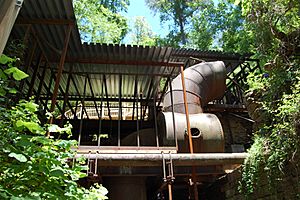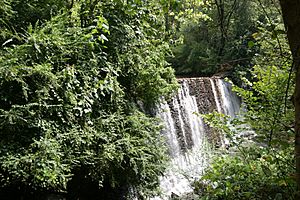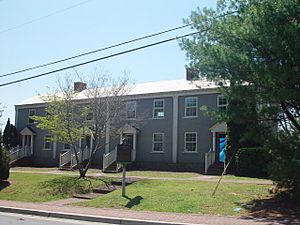Roswell Mill facts for kids
The Roswell Mill was a group of factories located in Roswell, Georgia, a town in Fulton County, Georgia. These mills were built near a stream called Vickery Creek. They were famous for making cloth, especially from cotton grown on large farms nearby. At its busiest, the Roswell Mill was the biggest cotton mill in northern Georgia.
Over time, the mill grew and started making other things too, like wool and flour. Different owners ran the mill through the years, and it kept making textiles until it finally closed down in 1975.
Contents
How the Mill Started
The very first mill was started by a rich businessman named Roswell King. He came from Connecticut but had lived in a town called Darien, Georgia. Roswell King had experience managing large farms and keeping careful records. This made him a great choice to run a factory.
Who Built It?
Construction on the first mill began in 1836. Roswell King owned enslaved people, and many of them helped build his home and the first mill. Later, two of Roswell's sons, Barrington and Ralph King, moved to the area to help with the new business. Five other families from Darien also moved to Roswell. The town of Roswell officially became part of Fulton County, Georgia in 1854. In 1847-1848, many workers got sick with mumps and measles. This happened because they lived and worked very close together in small, dark spaces.
What the Buildings Were Like
The mill used Hydropower from Vickery Creek to power its machines. Farms nearby provided the raw cotton. The first building was four stories tall. It was 88 feet long and 48 feet wide. Later, it was made even bigger. The Roswell Mill company officially started in 1839.
The King family also built two buildings called "The Bricks." These were homes for the mill workers. In 1853, a second mill was added. Before the Civil War, the mill complex had grown to include six different buildings.
The Mill During the Civil War
The Roswell Mills are most famous for their part in making supplies for the Confederate Army during the American Civil War. They produced a special fabric called "Roswell Gray." This fabric was used to make Confederate military uniforms. Because the mill was so important for the South's army, a Union general named Gerrard took control of it on July 5, 1864. He was working for General Sherman. Before Gerrard could reach it, Confederate soldiers burned the bridge over Vickery Creek.
Two days later, General William Tecumseh Sherman gave an order. He said to arrest all the mill owners and workers for treason. Treason means betraying your country. He wanted them sent north. He also said the women could find jobs in Indiana. He mentioned "foreigners" because the mill owners had put a French flag on the mills. They also put a French worker in charge. This was probably a trick to try and protect the mills.
What Happened to the Workers?
When the Union troops took the mill, they also captured about 400 mill workers. Most of these workers were women and children. The adult men were away fighting in the Civil War. The Union soldiers took these workers to Marietta, Georgia. From there, they were sent north on trains.
All the mill workers were accused of treason. They stayed for a week at the Georgia Military Institute. Then, they were sent north, many to Indiana. They were left to take care of themselves in towns that already had many people. Some died from hunger or cold. In 1865, a new mill opened that gave them jobs. We don't know what happened to many of these women. Most who survived stayed in the North. Only a few ever returned to Georgia.
After the War
After the Civil War, one of the cotton mills and the wool factory were rebuilt. In 1882, a second cotton mill was built.
During the Reconstruction period and into the 1900s, the Roswell Manufacturing Company changed a lot. In 1897, the mills started using steam power. This helped them make more products. But the mill still needed Vickery Creek for water. In 1920, a company from South Carolina bought the mill complex for $800,000. At that time, the mill had many machines, showing how much it could produce.
The mill changed owners often. This suggests it was becoming less valuable as competition grew. In 1926, lightning struck the mill and caused a big fire. The damage cost about $400,000. Another company bought the mill in 1947.
In 1975, the mill stopped working. This happened because companies started making cotton products in other countries. We don't know much about what happened to the mill after 1950. It seems the mill lost its importance when the time of "King Cotton" ended.
Parts of the mill were added to the Roswell Historic District in 1974. This means they are important historical places.
The Mill Today
The old Roswell Mills are now managed by the U.S. National Park Service. They are part of the Chattahoochee River Recreation Area. This is a popular place for visitors. People enjoy its nature trails, running paths, and rich history. You can still see parts of the old buildings. The covered bridge over Vickery Creek has been rebuilt.
A sculpture of a broken column stands near the mill. It is a memorial to the workers who were sent away. The monument was put up in 2000. This happened because people became more interested in the sad story of the deportation. This story had been mostly forgotten after the Civil War.





